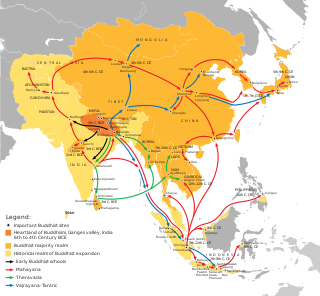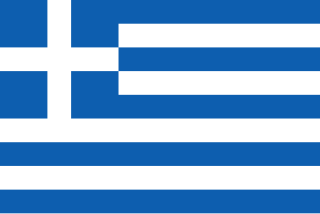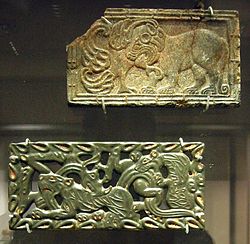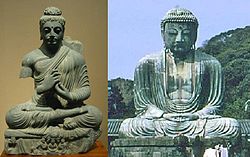
Hārītī (Sanskrit), also known as Chinese: 鬼子母(神); pinyin: Guǐzǐmǔ(shén), Japanese: 鬼子母神, romanized: Kishimojin, is both a revered goddess and demon, depending on the Buddhist tradition. She is one of the Twenty-Four Protective Deities of Mahayana Buddhism.

Kanishka I, Kanishka or Kanishka the Great, was an emperor of the Kushan dynasty, under whose reign the empire reached its zenith. He is famous for his military, political, and spiritual achievements. A descendant of Kujula Kadphises, founder of the Kushan empire, Kanishka came to rule an empire extending from Central Asia and Gandhara to Pataliputra on the Gangetic plain. The main capital of his empire was located at Puruṣapura (Peshawar) in Gandhara, with another major capital at Mathura. Coins of Kanishka were found in Tripuri.

Buddhism in Japan was first established in the 6th century CE, derived from Chinese Buddhism. Most of the Japanese Buddhists belong to new schools of Buddhism which were established in the Kamakura period (1185-1333). During the Edo (Tokugawa)-period (1603–1868), Buddhism was controlled by the feudal Shogunate. The Meiji-period (1868–1931) saw a strong response against Buddhism, with persecution and a forced separation between Buddhism and Shinto.

Greco-Buddhism or Graeco-Buddhism denotes a supposed cultural syncretism between Hellenistic culture and Buddhism developed between the 4th century BC and the 5th century AD in Gandhara, in present-day Pakistan and parts of north-east Afghanistan. While the Greco-Buddhist art shows clear Hellenistic influences, the majority of scholars do not assume a noticeable Greek influence on Gandharan Buddhism beyond the artistic realm.

Vajrapāṇi is one of the earliest-appearing bodhisattvas in Mahayana Buddhism. He is the protector and guide of Gautama Buddha and rose to symbolize the Buddha's power.

Niō (仁王) are two wrathful and muscular guardians of the Buddha standing today at the entrance of many Buddhist temples in East Asian Buddhism in the form of frightening wrestler-like statues. They are dharmapala manifestations of the bodhisattva Vajrapāṇi, the oldest and most powerful of the Mahayana Buddhist pantheon. According to scriptures like the Pāli Canon as well as the Ambaṭṭha Sutta, they travelled with Gautama Buddha to protect him. Within the generally pacifist tradition of Buddhism, stories of dharmapalas justified the use of physical force to protect cherished values and beliefs against evil. They are also seen as a manifestation of Mahasthamaprapta, the bodhisattva of power that flanks Amitābha in Pure Land Buddhism and as Vajrasattva in Tibetan Buddhism.

The Greco-Buddhist art or Gandhara art is the artistic manifestation of Greco-Buddhism, a cultural syncretism between Ancient Greek art and Buddhism. It had mainly evolved in the ancient region of Gandhara, located in the northwestern fringe of the Indian subcontinent.

Fūjin or Fūten, sometimes also known as Ryobu, is the Japanese god of the wind and one of the eldest Shinto gods. He is portrayed as a terrifying wizardly demon, resembling a red-headed green-skinned humanoid wearing a leopard skin, carrying a large bag of winds on his shoulders. In Japanese art, the deity is often depicted together with Raijin, the god of lightning, thunder and storms.

Buddhism entered Han China via the Silk Road, beginning in the 1st or 2nd century CE. The first documented translation efforts by Buddhist monks in China were in the 2nd century CE via the Kushan Empire into the Chinese territory bordering the Tarim Basin under Kanishka. These contacts transmitted strands of Sarvastivadan and Tamrashatiya Buddhism throughout the Eastern world.

The Bimaran casket or Bimaran reliquary is a small gold reliquary for Buddhist relics that was removed from inside the stupa no.2 at Bimaran, near Jalalabad in eastern Afghanistan.

Buddhist art is visual art produced in the context of Buddhism. It includes depictions of Gautama Buddha and other Buddhas and bodhisattvas, notable Buddhist figures both historical and mythical, narrative scenes from their lives, mandalas, and physical objects associated with Buddhist practice, such as vajras, bells, stupas and Buddhist temple architecture. Buddhist art originated in the north of the Indian subcontinent, in modern India, Pakistan and Afghanistan, with the earliest survivals dating from a few centuries after the historical life of Siddhartha Gautama from the 6th to 5th century BCE.

Sculpture in the Indian subcontinent, partly because of the climate of the Indian subcontinent makes the long-term survival of organic materials difficult, essentially consists of sculpture of stone, metal or terracotta. It is clear there was a great deal of painting, and sculpture in wood and ivory, during these periods, but there are only a few survivals. The main Indian religions had all, after hesitant starts, developed the use of religious sculpture by around the start of the Common Era, and the use of stone was becoming increasingly widespread.

Ganesha is a prominent Hindu god. He is the god of Beginnings, Wisdom and Luck and worshipped as the Remover of Obstacles. Ganesha is easily recognized from his elephant head. Devotion to Ganesha is widely diffused and extends to Jains and Buddhists and beyond India.

Buddhism in Central Asia mainly existed in Mahayana forms and was historically especially prevalent along the Silk Road. The history of Buddhism in Central Asia is closely related to the Silk Road transmission of Buddhism during the first millennium of the common era.

The Indo-Greeks practiced numerous religions during the time they ruled in the northwestern Indian subcontinent from the 2nd century BCE to the beginning of the 1st century CE. In addition to the worship of the Classical pantheon of the Greek deities found on their coins, the Indo-Greeks were involved with local faiths, particularly with Buddhism, but also with Hinduism and Zoroastrianism.

The legacy of the Indo-Greeks starts with the formal end of the Indo-Greek Kingdom from the 1st century, as the Greek communities of central Asia and northwestern India lived under the control of the Kushan branch of the Yuezhi, Indo-Scythians and Indo-Parthian Kingdom. The Kushans founded the Kushan Empire, which was to prosper for several centuries. In the south, the Greeks were under the rule of the Scythian Western Kshatrapas.

Buddhism has existed in Greece since antiquity. Today, there is a sizable Buddhist community in Greece, comprising immigrants and native Greek converts. Buddhism has influenced Greek literary tradition to some extent, as evident in the works of Nikos Kazantzakis.

Nana was an ancient Eastern Iranian goddess worshiped by Bactrians, Sogdians and Chorasmians, as well as by non-Iranian Yuezhi, including Kushans, as the head of their respective pantheons. She was derived from the earlier Mesopotamian goddess Nanaya. Attempts to connect her with Inanna (Ishtar) instead depend on the erroneous notion that the latter was identical with Nanaya, which is considered outdated. She was regarded as an astral deity, and in Sogdian art was depicted representations of the sun and the moon. Kushan emperors additionally associated her with royal power. In Sogdia she might have also developed an otherwise unattested warlike aspect, as evidenced by murals showing her in battles against demons. She was seemingly associated with the Sogdian counterpart of Tishtrya, Tish, who might have been regarded as her spouse.

Central Asian art is visual art created in Central Asia, in areas corresponding to modern Kyrgyzstan, Kazakhstan, Uzbekistan, Turkmenistan, Azerbaijan, Tajikistan, Afghanistan, Pakistan, and parts of modern Mongolia, China and Russia. The art of ancient and medieval Central Asia reflects the rich history of this vast area, home to a huge variety of peoples, religions and ways of life. The artistic remains of the region show a remarkable combinations of influences that exemplify the multicultural nature of Central Asian society. The Silk Road transmission of art, Scythian art, Greco-Buddhist art, Serindian art and more recently Persianate culture, are all part of this complicated history.

Gandhāran Buddhism refers to the Buddhist culture of ancient Gandhāra which was a major center of Buddhism in northwestern Pakistan from the 3rd century BCE to approximately 1200 CE. Ancient Gandhāra corresponds to modern day north Pakistan, mainly the Peshawar valley and Potohar plateau as well as Afghanistan's Jalalabad. The region has yielded the Gandhāran Buddhist texts written in Gāndhārī Prakrit the oldest Buddhist manuscripts yet discovered. Gandhāra was also home to a unique Buddhist artistic and architectural culture which blended elements from Indian, Hellenistic, Roman and Parthian art. Buddhist Gandhāra was also influential as the gateway through which Buddhism spread to Central Asia and China.

























